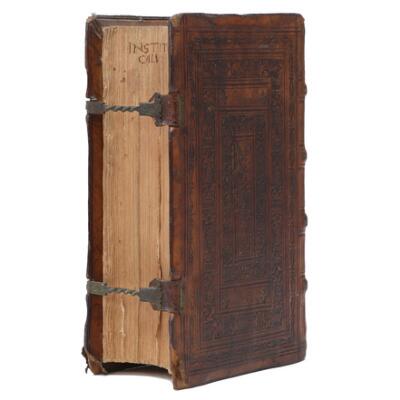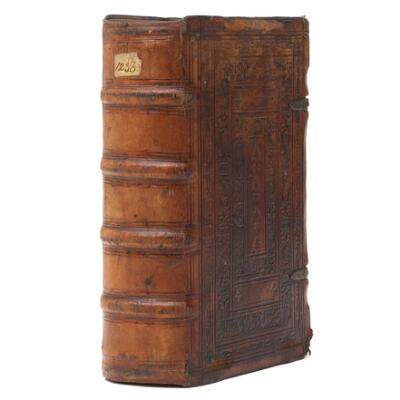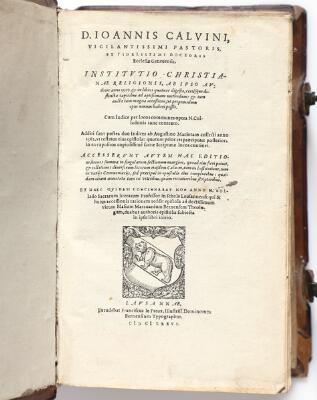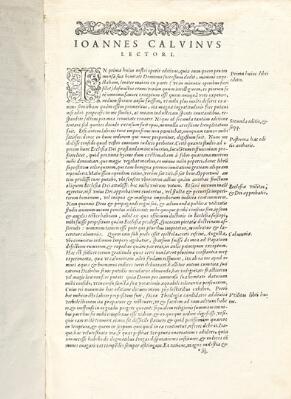An important edition of the Institutio.
The “Institutio Christianae Religionis” (Institutes of the Christian Religion) by Jean Calvin is a seminal work of Christian theology, remaining one of the most influential works in Protestant Christianity, shaping Reformed theology and impacting Christian thought and practice for centuries. Some of the reasons for its success can be summarized in a few points.
1.Comprehensive Systematic Theology: The “Institutio” is a comprehensive and systematic exposition of Reformed theology. Calvin covers a wide range of theological topics, including the knowledge of God, the nature of the Trinity, the doctrine of predestination, the sacraments, and the Christian life.
2.Clarity and Organization: Calvin’s writing is characterized by its clarity and logical organization. He presents his arguments in a structured manner, making it accessible to both theologians and laypeople
3.Emphasis on Scripture: Calvin’s theology is deeply rooted in the authority of Scripture. He constantly refers to biblical texts to support his theological positions and considers the Bible as the primary source of Christian doctrine
4.Sovereignty of God: One of the central themes in Calvin’s “Institutio” is the sovereignty of God. He emphasizes God’s control over all aspects of creation, including human salvation and predestination.
5.Doctrine of Predestination: Calvin’s doctrine of predestination is a prominent feature of the “Institutio.” He argues for the doctrine of election, stating that God has chosen some individuals for salvation, while others are left in their fallen state.
6.Church and Sacraments: Calvin also addresses ecclesiology, emphasizing the importance of the church as a visible community of believers. He discusses the sacraments, particularly Baptism and the Lord’s Supper, as essential means of grace
7.Devotional and Pastoral Elements: While a systematic theological work, the “Institutio” also contains pastoral and devotional elements. Calvin’s writing aims to guide believers in their spiritual journey and understanding of the Christian faith.
Notable editions:
First Edition (1536): The original edition of the “Institutio” was published in Latin in 1536. It consisted of six chapters and was relatively shorter compared to later expanded versions
Second Edition (1539): Calvin significantly expanded the “Institutio” in the second edition, published in 1539. It contained seventeen chapters and underwent substantial revisions and additions to clarify and expand upon his theological views.
Third Edition (1543): The third edition of the “Institutio” was published in 1543 and saw further revisions and expansions. It included new chapters and refined discussions on various theological topics.
Fourth Edition (1559): The fourth and final Latin edition of the “Institutio” was published in 1559. This edition is considered the definitive version and is the most widely known and studied. It comprised four books and consisted of eighty chapters.
Lausanne edition (1576) : The Lausanne edition of 1576 was edited by Theodore Beza, a prominent theologian and successor to Calvin. Beza made revisions and additions to the original Latin text of the “Institutio,” incorporating his own theological insights and clarifications.
The Lausanne edition includes Beza’s dedicatory letter to Queen Elizabeth I of England and a preface written by him. It is important to note that Beza’s editorial changes and additions reflect his own theological perspective and understanding of Calvin’s teachings.
The Lausanne edition of 1576 served as a widely circulated version of the “Institutio,” influencing subsequent editions and translations. It played a significant role in the dissemination of Calvin’s thought and the development of Reformed theology.
Our copy has an exceptional provenance, the Valdemar’s Castle on the Danish island of Tåsinge, build by the Royal family and then inhabited by the family of Denmark’s naval hero Niels Juel. In 1677 he defeated the Swedish fleet at the Battle of Køge Bay and subsequently settled at Valdemar’s Castle on Tåsinge. His family has lived there for 12 generations and nearly 350 years. One of the castle’s previous owners was Christian IV’s son Valdemar Christian, whom the castle was named after.




